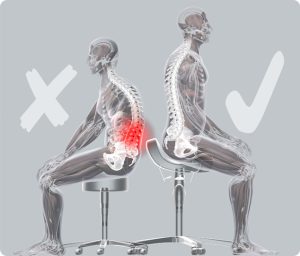Preventing WMSDs and Pain in Dentistry: Tip 2
The previous chapter, Preventing WMSDs and Pain in Dentistry: Tip 1, provided one method for managing some of the risk factors listed in the What are Work-Related Musculoskeletal Disorders? chapter. This chapter will focus on the second tip to manage some of risk factors. Additional tips can be found in the following chapters.
Tip 2: Utilize Safe and Ergonomically Designed Equipment
Research shows that using ergonomically designed equipment and magnification during procedures has had positive effects on reducing awkward body postures and neck flexion, thereby minimizing the risk of developing WMSDs and encouraging practitioners to stay in neutral body positions.[1]
For example, dental loupes that are manufactured correctly can provide many benefits to students in terms of practice and productivity. Listed below are a few of the benefits:
- Increased performance and productivity
- Most effective type of equipment to reduce musculoskeletal pain symptoms
- Improved visual acuity and operator posture
- Improved treatment outcomes
For these reasons, the purchase of dental loupes for all students in the School of Dentistry is recommended upon entry into the clinical portion of each program. For further information and guidelines on selecting dental loupes, there has been a video created by Dr. Valachi available for purchase that goes into further detail on ergonomic guidelines for the selection of dental loupes. This video may be accessed here.

In addition, the use of saddle seats has become more widely used for improved body posture and pain management. According to more recent studies, saddle seats allow for a more neutral positioning of the spine by positioning the lumbar spine into a slight anterior tilt with hips angled between 105-125 degrees, thus creating the natural “S” shape of the spine and preventing kyphotic positioning from occurring which leads to more back pain[2].
Listed below are a few benefits from using saddle seats:
- Improved body posture
- Improved shoulder stability, allowing for more precise and accurate finger movements
- Reduced lower back and hip pain
While the UMN School of Dentistry does not currently use saddle seats, it is important to understand the benefits of using them so you can make informed decisions upon entry into the clinical world for which seat would benefit you the most. For more information on the selection of saddle stools, a resource guide has been included in the appendix that discusses the pros/cons of the most recommended saddle stools.
- Kamal, A. M., Ahmed, D. R. M., Habib, S. F. K., & Al-Mohareb, R. A. (2020). Ergonomics of preclinical dental students and potential musculoskeletal disorders. Journal of Dental Education, 84(12), 1438–1446. https://doi.org/10.1002/jdd.12369 ↵
- Plessas, A., & Bernardes Delgado, M. (2018). The role of ergonomic saddle seats and magnification loupes in the prevention of musculoskeletal disorders. A systematic review. International Journal of Dental Hygiene, 16(4), 430–440. https://doi.org/10.1111/idh.12327 ↵
